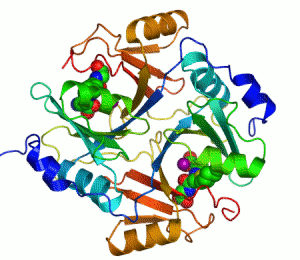 |
 |
 |
 |
 |
 |
 |
 |
 |
 |
 |
 |
 |
 |
 |
 |
 |
 |
 |
 |
 |
 |
 |
 |
 |
 |
 |
 |
 |
 |
 |
 |
 |
|
|
Fat and Mass Associated or FTO |
|
| Welcome! |
|
|
 |
|
|
|
|
This is my YFG or "Your Favorite Gene" Project page. Feel free to look around!
Enjoy!
~ Aditi
Page 2 |
|
|
|
|
|
This is a picture of the protein that this gene produces. |
|
|
|
|
|
|
|
|
 |
|
|
|
|
|
Location: |
|
|
"The typical message has been that if you are overweight it is due to sloth and gluttony and it is your fault...This work is suggesting that there is also a genetic commponent." ~~ Prof Andrew Hattersley (2) |
|
|
|
|
|
|
The protein itself is prevalent in the brain and the endocrine system, a system in human dealing with the regulation of hormones. In the endocrine system, this protein is best found around the adrenal glands; whereas, in the brain, it is found in the hypothalamus and pituitary glands. (1)
In regards to the human chromosme, it is found on chromosme 16. It is specifically positioned at 3,015.74 - 3,039.88 (24.14). (4) It is on the lower arm of the chromosome on the 12.2 band. This image will help in understanding the significance of these numbers: (5)
CLICK HERE!!! |
|
|
|
|
|
Other genes that may play a role in obesity: |
|
|
|
|
|
The true function of this gene is yet to be discovered. Since the gene itself was discovered one and a half years ago, scientists are still in the experimental process. However, some results have been published. This gene has been present in people with diseases such as diabetes, hypertension, and cardiovascular diseases. It does not cause them. Furthermore, it has been revealed that this gene catalyzes Fe(II)- and 2OG- dependent DNA demethylation. (6) It uses 2-oxoglutarate and iron to aid its own function.
Also, one gene that may play a role in obesity is located on chromosome 7. It is the gene that produces leptin, a hormone required for regulating energy usage. In mice, it has been proven to make the mouse three times the body weight and five times the mass of a normal mouse. In humans, higher concentrations of leptin are noted in the blood of obese people. (7) |
|
|
|
|
|
How was it discovered? |
|
|
|
Like some scientific discoveries, this gene was discovered by accident. Scientists were looking for the key genetic factor for having Type II Diabetes. They unexpectedly came across the FTO gene and noted an increase in body weight of the individuals. (2) This results of the tests were enforced by studies on twins. (3) |
|
|
|
Other information: |
|
|
|
This gene has several variants through a phenomenon known as alternate splicing. It forms four variants to be specific. The first one is the widely known and sequenced variant. The sequence provided below has this variant. It is also named the "canonical" sequence. The second variant differes in that its proteins 1 to 378 are missing as well as several mutated proteins from 379 tp 413. The third variant has the protein 1 to 445 missing as well as mutations in the proteins of 446 to 455. The fourth vairant solely has proteins 1 to 399 missing. Other than the very first variant, non of the others are confirmed through experimentation. |
|
|
|
This web page was produced as an assignment for an AP Biology course at Montgomery High School. |
|
|
|
Next Page --> |
|
|
<-- Previous Page |
|
|
|
|
|
|
|
|
